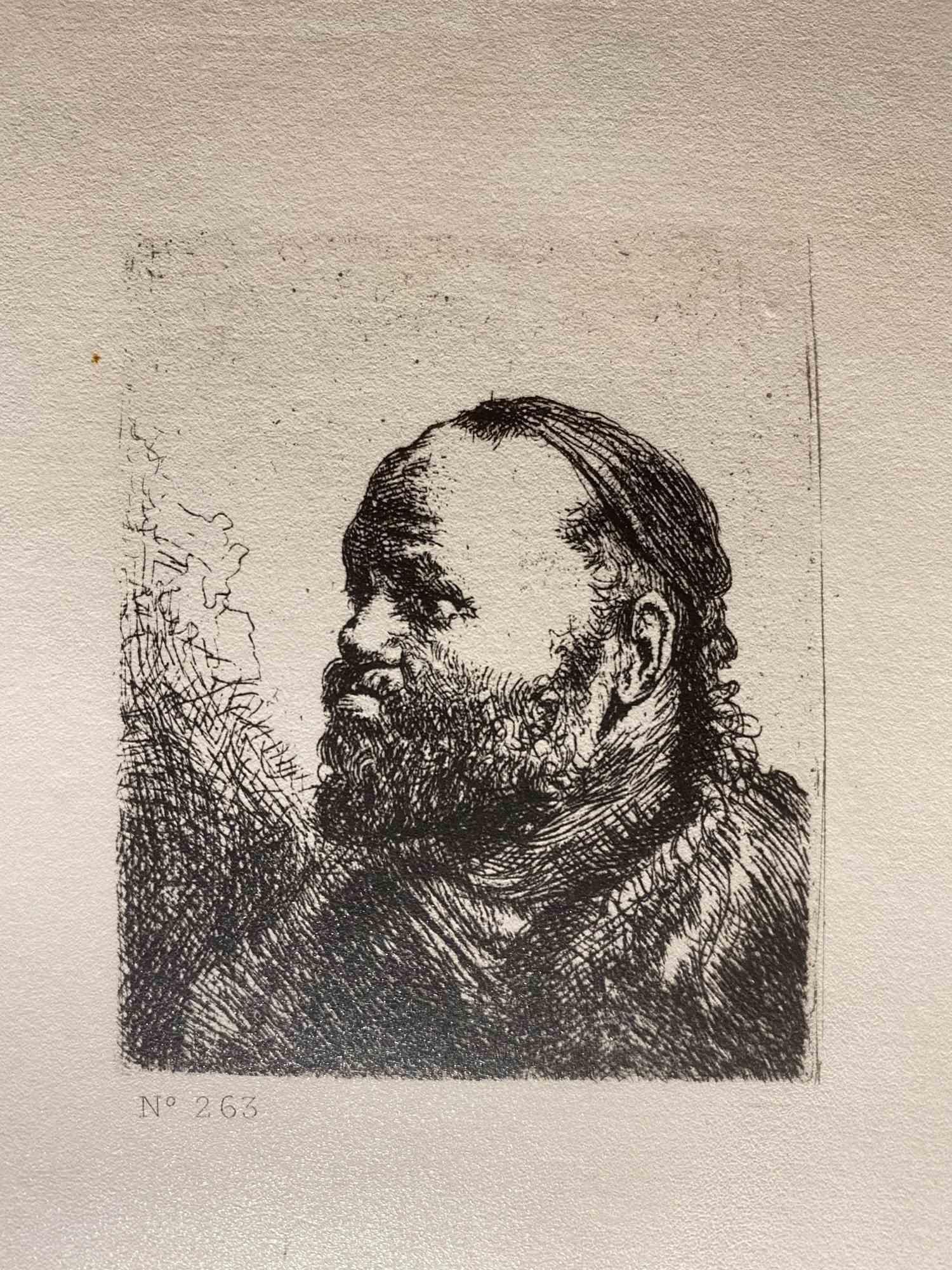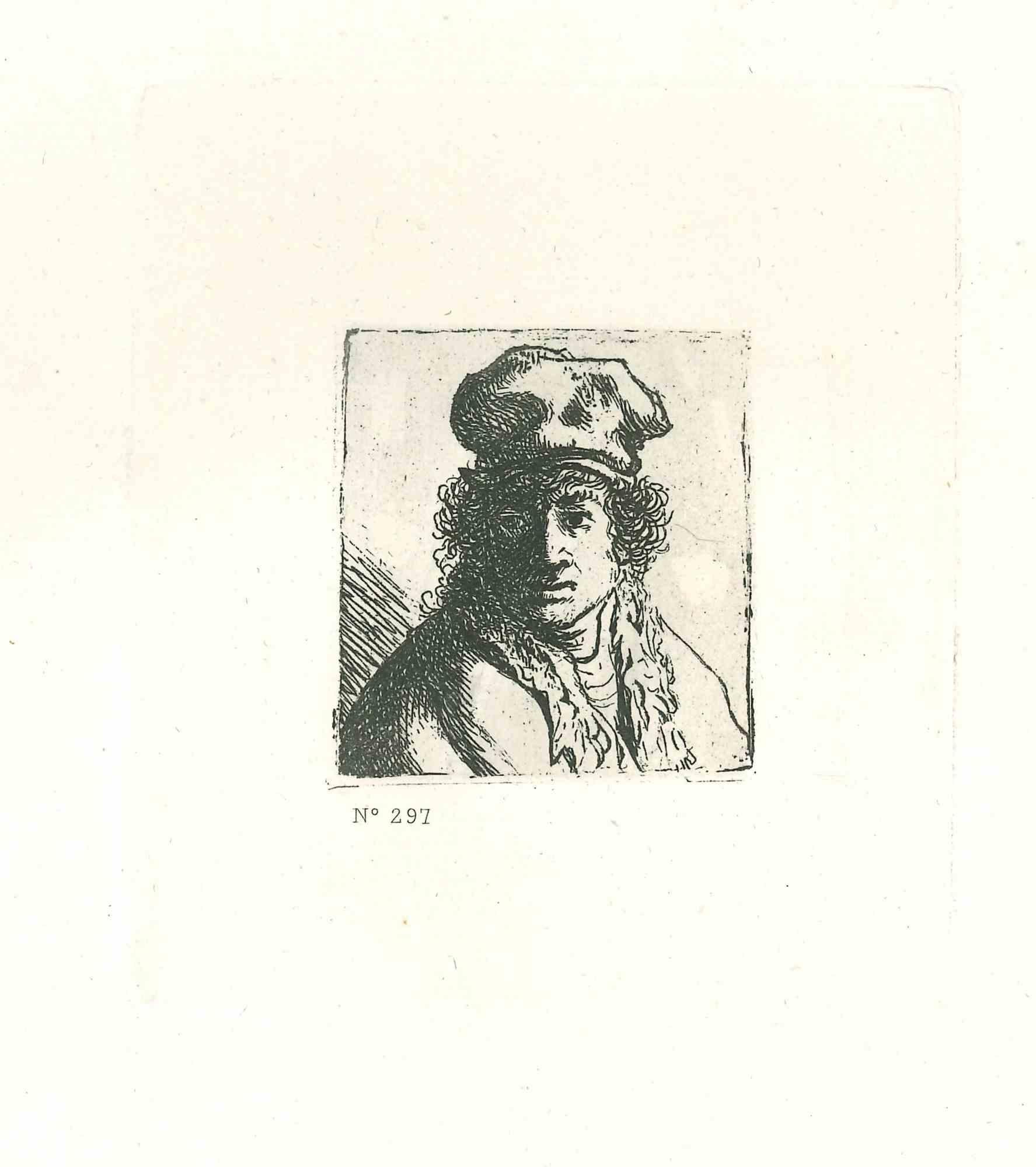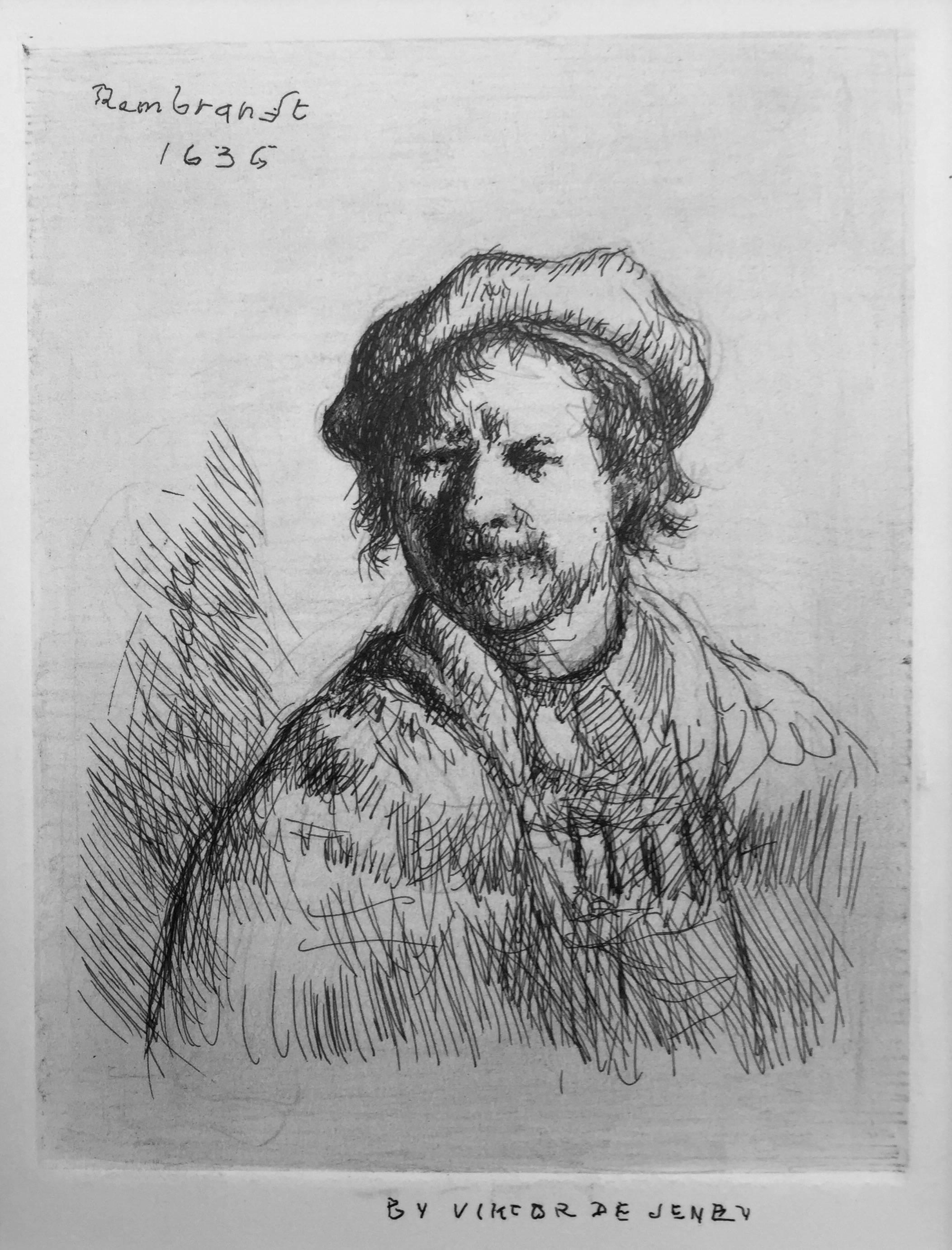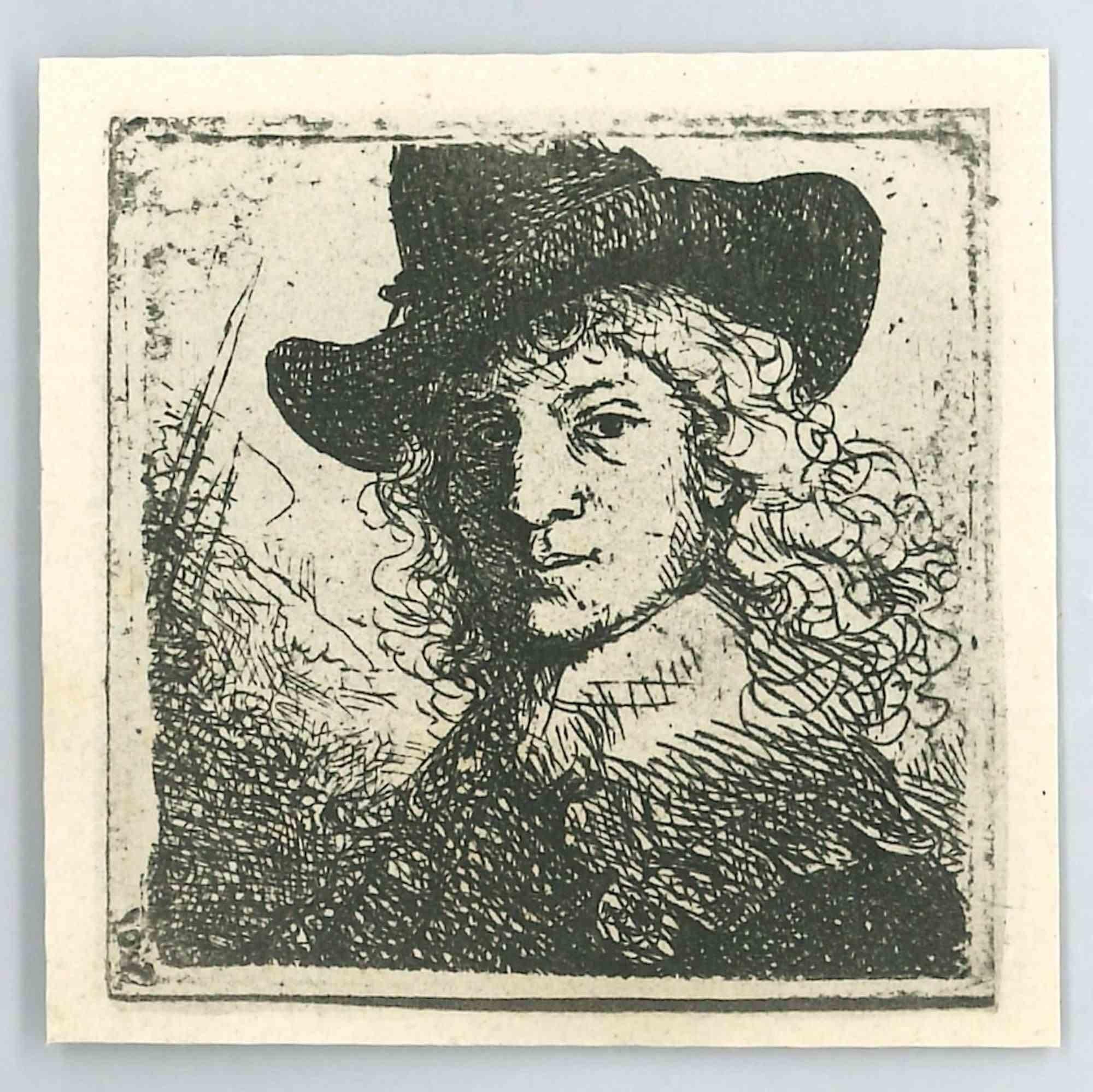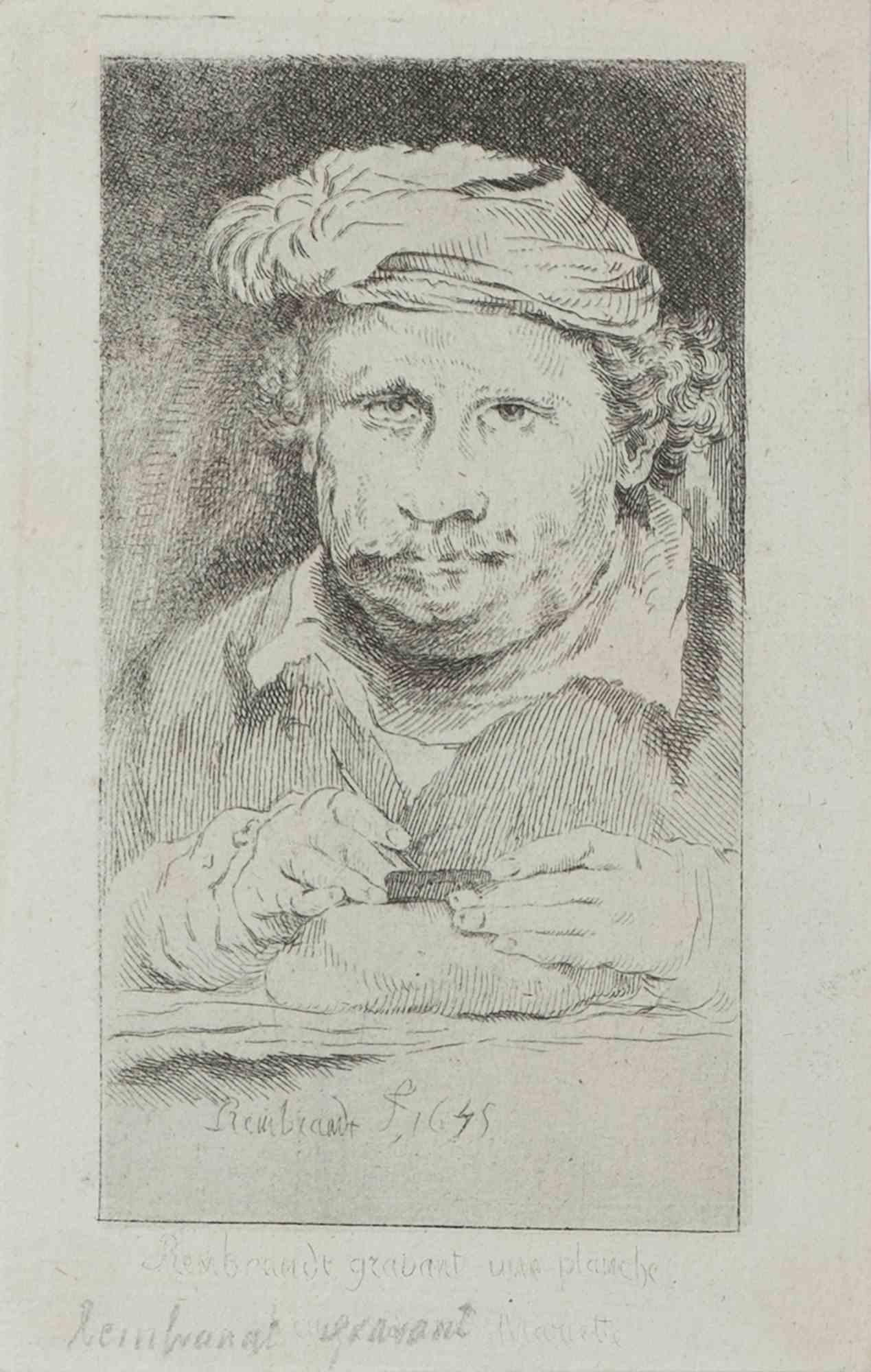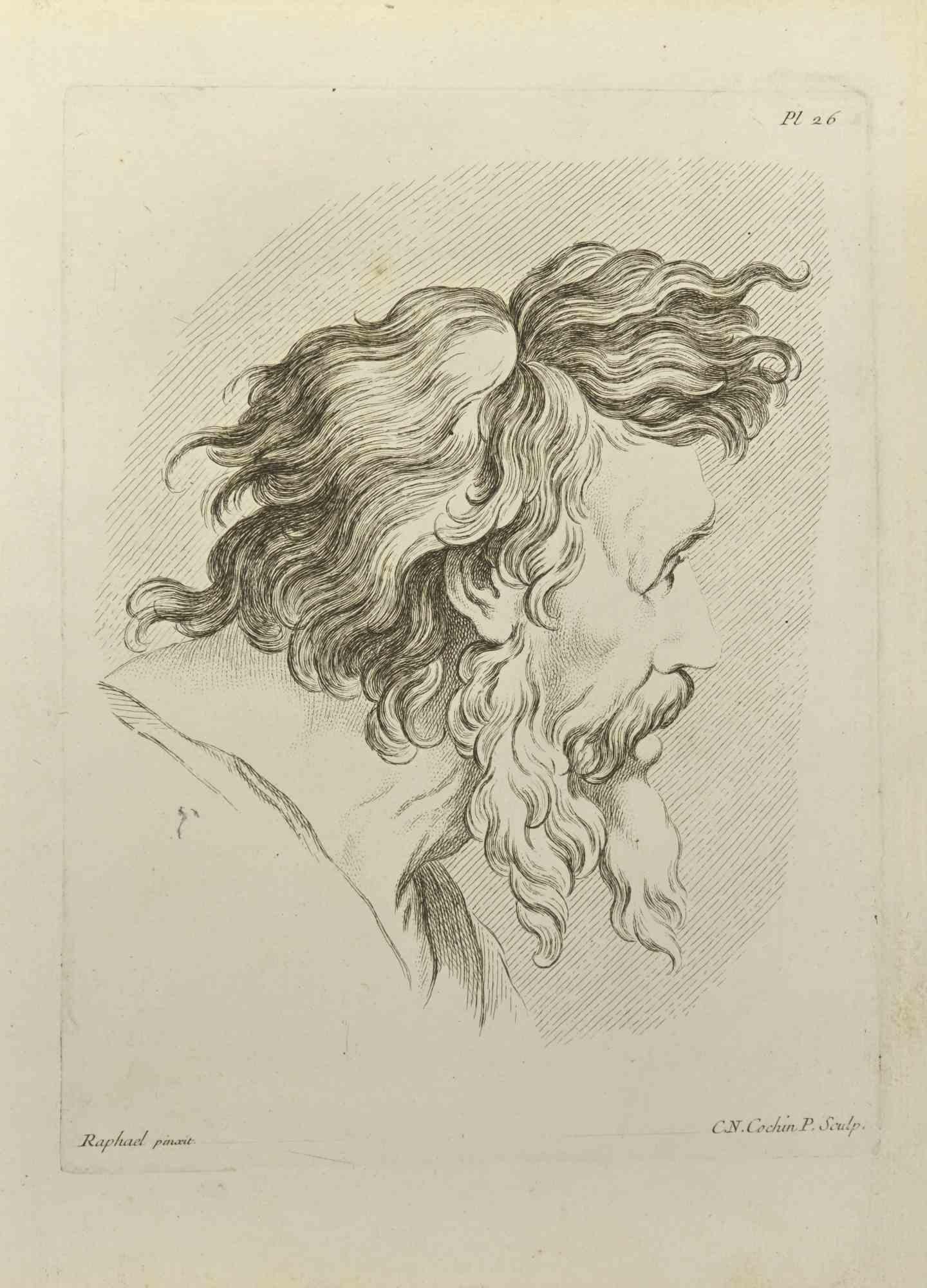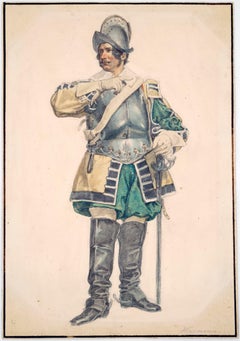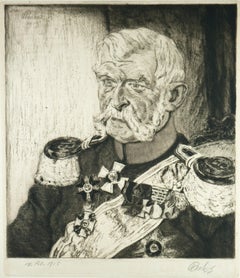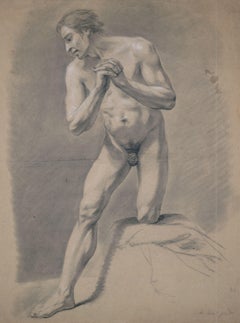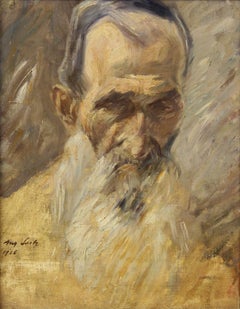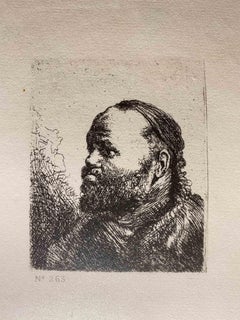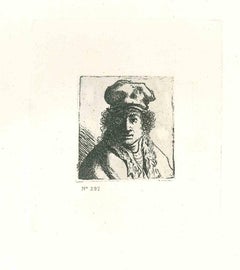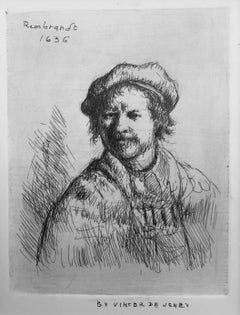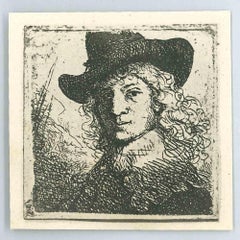Items Similar to Half-length portrait of a man with beard - A Rembrandt of the 18th century -
Want more images or videos?
Request additional images or videos from the seller
1 of 8
Johann Friedrich BauseHalf-length portrait of a man with beard - A Rembrandt of the 18th century -1782
1782
$427.46
$534.3320% Off
£323.06
£403.8320% Off
€360
€45020% Off
CA$597.13
CA$746.4120% Off
A$649.62
A$812.0220% Off
CHF 342.79
CHF 428.4920% Off
MX$7,812.77
MX$9,765.9620% Off
NOK 4,324.20
NOK 5,405.2520% Off
SEK 4,024.35
SEK 5,030.4420% Off
DKK 2,742.38
DKK 3,427.9820% Off
About the Item
Johann Friedrich Bause (1738 Halle a. d. Saale - 1814 Weimar). Half-length portrait of a man with beard and cap after a drawing by Christian Wilhelm Ernst Dietrich. Etching and copper engraving, 20,4 x 16,7 cm (plate size), 37,5 x 27,8 cm (paper size), inscribed at lower left "C. W. E. Dietrich del.", signed and dated at lower right "J. F. Bause fec 1782".
Keil, no. 24. II. Brown tonal print with broad margins. Plate edge partly slightly browned and dusty in the wide margin.
- A Rembrandt of the 18th century -
About the artwork
The sitter, in the manner of Rembrandt, gazes out at the viewer with a penetrating gaze and yet, despite this sharpness, is given a painterly fluidity that contributes decisively to the attractive aura of this picture. The first version of the print, dating from 1777, was a pure etching. Bause's mastery of this technique, as well as of engraving, enabled him to create the finest nuances of light and shadow, as is particularly evident in the backlit strands of hair on the right side of the head. In 1782, after five years, Bause returned to the painting, which was unusual for the busy artist, and therefore this work has a special significance for Bause's artistic self-conception, especially as it was not a commissioned work. In the second attempt, Bause reworked the plate with a chisel, resulting in a more precise etching and a more concise depiction, culminating in the gaze. At the same time, however, the newly acquired sharpness is charged with atmosphere by the warm brown tone now used, to which the free hatchings, almost completely detached from the subject, also contribute, superimposing the coat on the collar, which has been made more precise with the graver.
The reworking that has taken place makes it clear that the graphic reproduction - in this case of a drawing by Dietrich - has not been conceived as the most meticulous possible copy, which is not even possible because of the medial leap from drawing or oil painting to graphic art, but as a new creation, which at the same time represents an interpretation of the reproduced work. Graphic reproduction is thus a creative art of interpretation, which is here sharpened to Bause's artistic self-conception. Georg Keil reports that Bause - like the sitter - had beautiful long hair, which he had styled every day. Whatever truth there may be in this anecdote, its true essence lies in the fact that Bause here shows himself as an artist refracted through the template of the drawing, which is reinforced by the fact that Dietrich's drawing refers to the self-portraits so central to Rembrandt's oeuvre.
"As a portrait engraver he [i.e. Bause] belongs to the most excellent masters. [...] The freedom and certainty of the painter are undiminished in his engraved portraits. The parts of the flesh are exquisitely treated with infinite delicacy and softness, and every substance is faithfully and truly expressed in its character".
About the artist
Johann Friedrich Bause was orphaned at an early age and trained himself as an artist, making him one of the great self-taught artists of the 18th century, along with Daniel Nikolaus Chodowiecki. Initially Bause engraved book decorations for booksellers in Halle, but in 1759 he went to Augsburg for a year to study the mezzotint technique under Johann Jacob Haid. In Augsburg he became friends with Anton Graff, who was about his age and who painted portraits of Bause in Augsburg. Later, during Bause's time in Leipzig, Graff stayed with Bause, who would engrave a total of 45 of his portraits, while Graff in turn portrayed Bause several times.
Back in Halle from Augsburg, Bause began to produce prints, preferring drawings by Georg Friedrich Wille, a Parisian artist whom he greatly admired. In 1766 he dedicated the print Die fleißige Hausfrau after Gerard Dou (Keil, 35) to Wille. Wille recognised Bause's talent and contacted him, which led to a correspondence that lasted until Wille's death in 1808.
In 1766 Bause was appointed by Adam Friedrich Oeser to teach copper engraving at the newly founded Leipzig Academy of Arts. In Leipzig Bause had a printing press installed in his house to keep the quality of the engravings at the highest level.
In 1786 Bause became an honorary member of the Prussian Academy and in 1796 of the Stockholm Academy. In 1809, with failing eyesight, he made his last engraving, a portrait of his son-in-law. In 1813, due to the French occupation, he left the city with his wife and widowed daughter and moved to Weimar, where he died soon after.
The artist's work, which fell into oblivion at the end of the 19th century, is gradually being rediscovered, as shown by the recent monographic exhibitions in Leipzig and Luxembourg.
Selected bibliography
Georg Keil: Catalog des Kupferstichwerkes von Johann Friedrich Bause, Leipzig 1849.
Nicole Linke: Johann Friedrich Bause. Ein heute kaum bekannter hallescher Kupferstecher des 18. Jahrhunderts. In: Von Nutzen und Vergnügen. Aus dem Kupferstichkabinett der Universität Halle, hrsg. v. Ralf-Torsten Speler, Halle 1999.
Stephan Brakensiek (Hrsg.): Leipziger Allerlei – Johann Friedrich Bause (1738–1814) und der Porträtstich im 18. Jahrhundert, Trier 2014.
GERMAN VERSION
Johann Friedrich Bause (1738 Halle a. d. Saale - 1814 Weimar). Brustbild eines Mannes mit Knebelbart und Mütze nach einer Zeichnung von Christian Wilhelm Ernst Dietrich. Radierung und Kupferstich, 20,4 x 16,7 cm (Plattenmaß), 37,5 x 27,8 cm (Papiermaß), links unten bezeichnet „C. W. E. Dietrich del.“, rechts unten signiert und datiert „J. F. Bause fec 1782“.
Keil, Nr. 24. II. Zustand in brauntonalem Abzug mit breitem Rand. Plattenkante teilweise leicht gebräunt und im breiten Rand angestaubt.
- Ein Rembrandt des 18. Jahrhunderts -
zum Kunstwerk
Die in rembrandtscher Manier dargestellte Person blickt den Betrachter durchdringend an und ist - trotz dieser Schärfe - doch in einem malerischen Fluidum gegeben, das entscheidend zur anziehenden Aura dieses Bildes beiträgt. Die aus dem Jahre 1777 datierende erste Version der Grafik war eine reine Radierung. Diese Technik beherrschte Bause ebenso virtuos wie den Kupferstich, so dass es ihm gelang, feinste Licht-Schatten-Nuancierungen zu erzeugen, wie sie insbesondere bei den auf der rechten Seite hinterleuchteten Strähnen der fülligen Haarpracht vor Augen stehen. Nach fünf Jahren wandte sich Bause 1782 erneut dem Bild zu, was für den vielbeschäftigen Künstler eine Besonderheit darstellt, weshalb diesem Werk für Bauses künstlerisches Selbstverständnis eine besondere Relevanz zukommt, zumal das Bild nicht als Auftragsarbeit entstanden ist. Im zweiten Anlauf überarbeitete Bause die Platte mit dem Grabstichel, was zu einer Präzisierung der Radierung führte, aus der die im Blick kulminierende Prägnanz der Darstellung resultiert. Zugleich wird die neu gewonnene Schärfe aber durch den nun verwendeten warmen Braunton erneut atmosphärisch aufgeladen, wozu auch die beinahe gänzlich vom dargestellten Gegenstand gelösten freien Schraffuren beitragen, die den mit dem Grabstickel präzisierten Mantel am Kragen überlagern.
Die erfolgte Überarbeitung verdeutlicht, dass die druckgrafische Reproduktion - in diesem Fall einer Zeichnung von Dietrich - nicht als möglichst akribische Kopie aufgefasst worden ist, was aufgrund des medialen Sprungs von der Zeichnung oder dem Ölbild in die Grafik auch gar nicht möglich ist, sondern als eine Neuschöpfung verstanden worden ist, die zugleich eine Interpretation des re-produzierten Werks darstellt. Die druckgrafische Reproduktion ist mithin eine schöpferische Kunst der Interpretation, die hier auf das künstlerische Selbstverständnis Bauses zugespitzt ist. Georg Keil berichtet, dass Bause - wie die dargestellte Person - schönes langes Haar gehabt hätte, das er jeden Tag frisieren zu lassen pflegte. Was an dieser Anekdote auch immer Wahres sein mag, liegt ihr wahrer Kern darin, dass sich Bause hier durch die Vorlage der Zeichnung gebrochen selbst als Künstler zeigt, was noch zusätzlich bestärkt wird, indem sich Dietrichs Zeichnung auf die in Rembrandts Oeuvre so zentralen Selbstbildnisse bezieht.
„Als Portraitstecher gehört er [d.i. Bause] zu den ausgezeichnetsten Meistern. [...] Die Freiheit und Sicherheit des Malers findet man ungeschmälert in seinen gestochenen Bildnissen wieder. Die Fleischpartien sind vortrefflich und mit unendlicher Zartheit und Weichheit behandelt, und jeder Stoff ist in seinem Charakter treu und wahr ausgedrückt.“
Georg Keil
zum Künstler
Der früh verwaiste Johann Friedrich Bause bildete sich im Selbststudium zum Künstler aus und gehört damit - wie Daniel Nikolaus Chodowiecki - zu den großen Autodidakten des 18. Jahrhunderts. Stach er zunächst Buchschmuck für Hallenser Buchhändler, ging Bause 1759 für ein Jahr nach Augsburg, um sich dort unter der Leitung von Johann Jacob Haid weiterzubilden und die Schabkunstmanier zu erlernen. In Augsburg schloss er mit dem etwa gleichaltrigen Anton Graff Freundschaft, der Bause in Augsburg porträtierte. Später, in Bauses Leipziger Zeit, logierte Graff bei Bause, der insgesamt 45 seiner Porträts stechen sollte, während Graff Bause seinerseits noch mehrfach porträtierte.
Von Augsburg zurück in Halle begann Bause Zeichnungen druckgrafisch umzusetzen, wobei er Zeichnungen des von ihm überaus geschätzten, in Paris ansässigen Georg Friedrich Wille bevorzugte. 1766 widmet er Wille das Blatt Die fleißige Hausfrau nach Gerard Dou (Keil, 35). Wille erkannte das Talent Bauses und trat mit ihm in Kontakt, woraus sich eine bis zu Willes Tod, im Jahre 1808, währende Brieffreundschaft entspann.
1766 wurde Bause von Adam Friedrich Oeser als Lehrer für Kupferstich an die neu gegründete Leipziger Zeichenakademie berufen. In Leipzig ließ sich Bause in seinem Haus eine Druckpresse installieren, um die Druckqualität der Stiche auf höchstem Niveau zu halten.
1786 wurde Bause Ehrenmitglied der preußischen Akademie, 1796 derjenigen von Stockholm. Mit nachlassendem Augenlicht fertigte er 1809 seinen letzten Stich, das Porträt seines Schwiegersohn, an. 1813 verließ er aufgrund der französischen Besatzung mit seiner Frau und seiner verwitweten Tochter die Stadt und übersiedelte nach Weimar, wo er bald darauf starb.
Das Oeuvre des im späten 19. Jahrhundert in Vergessenheit geratenen Künstler erfreut sich einer allmählichen Wiederentdeckung, wovon die jüngste in Leipzig und Luxemburg gezeigte monographische Ausstellung zeugt.
Auswahlbibliographie
Georg Keil: Catalog des Kupferstichwerkes von Johann Friedrich Bause, Leipzig 1849.
Nicole Linke: Johann Friedrich Bause. Ein heute kaum bekannter hallescher Kupferstecher des 18. Jahrhunderts. In: Von Nutzen und Vergnügen. Aus dem Kupferstichkabinett der Universität Halle, hrsg. v. Ralf-Torsten Speler, Halle 1999.
Stephan Brakensiek (Hrsg.): Leipziger Allerlei – Johann Friedrich Bause (1738–1814) und der Porträtstich im 18. Jahrhundert, Trier 2014.
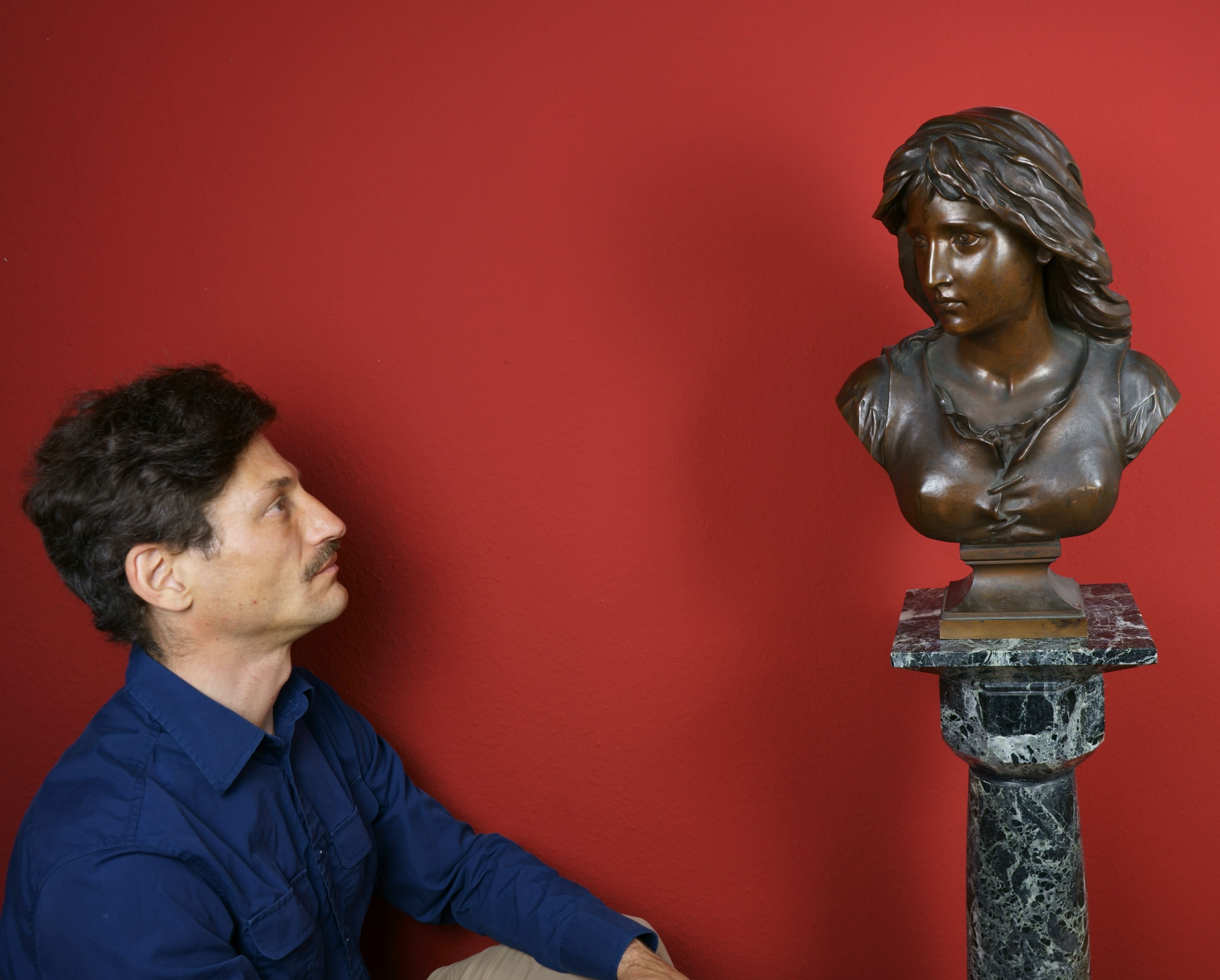
About the Seller
5.0
Vetted Professional Seller
Every seller passes strict standards for authenticity and reliability
Established in 2014
1stDibs seller since 2023
22 sales on 1stDibs
- ShippingRetrieving quote...Shipping from: Berlin, Germany
- Return Policy
More From This Seller
View AllThe actor Karl Seydelmann, probably as Max Piccolomini / - Theatrical Realism -
Located in Berlin, DE
Theodor Hosemann (1807 Brandenburg - 1875 Berlin), The actor Karl Seydelmann probably as Max Piccolomini, around 1840. Watercolor with pencil, 20.5 cm (height) x 14.7 cm (width), sig...
Category
1840s Realist Figurative Drawings and Watercolors
Materials
Paper
General Wilhelm von Blume - Visionary retrospective -
Located in Berlin, DE
Bernhard Pankok (1872 Münster - 1943 Baierbrunn), General Wilhelm von Blume, 1915, aquatint etching, 34 x 29.5 cm (sheet size), 26 x 22 cm (plate size), signed in the plate at upper left, in pencil at lower right and dated in pencil at lower left.
- At lower left old collection stamp, at the right broad margin with a small spot, otherwise very good condition.
About the artwork
The 1915 aquatint etching of General Wilhelm von Blume is based on a 1912 oil painting in the LWL-Museum für Kunst und Kultur in Münster. A second oil portrait of the general by Pankok is in the Staatsgalerie Stuttgart. When Pankok painted the first oil portrait in 1912, the general had already been retired for 16 years. It is therefore a retrospective portrait. Accordingly, the orientation of his head is such that he is looking back in both the oil painting and the etching. Without fixing on anything in particular, he looks thoughtfully inwards and reflects on his life. Uniformed and highly endowed, it is his military activities in particular that he is reviewing attentively and, as his gaze reveals, quite critically.
Pankok has literally written the sum of his experiences on Wilhelm von Blume's face: The physiognomy is a veritable landscape of folds, furrows, ridges and gullies, all the more striking against the flat background. It is clear that each of the medals was also won through suffering. However, by breaking the boundaries of the picture, his bust appears as an unshakable massif, which gives the general a stoic quality.
The fact that the design of the portrait was important to Pankok can be seen from the different versions, the present sheet being the third and probably final revision, which Pankok dates precisely to 18 February 1915. Compared with the previous state, the light background now has a dark area against which the sitter's face stands out, the dark background in turn combining with the uniform to create a new tension in the picture.
Pankok's taking up of the portrait of the high-ranking military veteran and its graphic reproduction can also be seen in relation to the First World War, which had broken out in the meantime. In the face of modern weapons of mass destruction, Wilhelm von Blume's warfare and military writings were relics of a bygone, more value-oriented era.
About the artist
After studying at the Düsseldorf Art Academy from 1889 to 1891 under Heinrich Lauenstein, Adolf Schill, Hugo Crola, and Peter Janssen the Elder, Bernhard Pankok went to Munich in 1892, where he worked primarily as a graphic artist for the two major Jugendstil magazines "Pan" and "Jugend," which established his artistic success. Through this work he met Emil Orlik, with whom he had a lifelong friendship.
In 1897, he exhibited his first furniture, and in 1898, together with Richard Riemerschmid, Bruno Paul and Hermann Obrist...
Category
1910s Realist Portrait Prints
Materials
Etching
$455 Sale Price
20% Off
Male Nude / - The Drama of the Nude -
Located in Berlin, DE
Johann Heinrich Meil (1730 Gotha - 1820 Berlin), Male Nude, 1807. White heightened, occasionally wiped charcoal drawing on brownish paper, 51 cm x 39.5 cm, signed “J.[ohann] H.[einri...
Category
Early 19th Century Rococo Nude Drawings and Watercolors
Materials
Paper
$740 Sale Price
20% Off
Half-length portrait of an elderly bearded man - Melancholy of a prophet -
Located in Berlin, DE
Friedrich August Seitz (1902 Staffort - 1944 Belgrade). Half-length portrait of an elderly man with a beard. Oil on canvas, 42 x 34 cm (visible seize), 58 x 50 cm (frame), signed and...
Category
1920s Expressionist Figurative Paintings
Materials
Oil
Half-length portrait of a Pharisee - In the shadow of betrayal -
Located in Berlin, DE
Hermann Prell (1854 Leipzig - 1922 Dresden-Loschwitz). Half-length portrait of a Pharisee, 1885. Sketch for the right-hand figure in the painting Judas Iscariot, 1886. Pencil drawing heightened with opaque white and black chalk on beige-grey wove paper (papier vélin), 34 x 27.8 cm (visible size), 52 x 45 cm (mount), signed, dated and inscribed "H. PRELL 1885 zu 'Judas'".
Minor browning, collection stamp on the reverse.
- In the shadow of betrayal -
About the artwork
This painting is the sketch for the head of the Pharisee offering the coins to Judas in one of Herrmann Prell's major works, the painting Betrayal of Judas, completed in 1886. The painting belongs to the Staatliche Kunstsammlungen Dresden and is illustrated in Adolf Rosenberg: Prell, Bielefeld and Leipzig 1901, p. 21 (Fig. 19). It is especially highlighted in Thieme-Becker (vol. 27, p. 376).
Hermann Prell, Betrayal of Judas, 1886
The monumental head, which fills the picture and is distinguished by its ornamented robe, is almost a lost profile, which in the executed painting is justified by the Pharisee's turning towards Judas. Despite the fact that the sitter withdraws from the viewer by turning away, it was necessary to artistically elaborate the motivation for the purchase of one of Christ's disciples, which is why the drawing focuses on the expression of the face, while the 'accessories' are treated in a more summary manner.
In characterising the face, Hermann Prell performs a balancing act: since the Pharisee, despite his destructive actions, is an actor in the history of salvation, the head must show a dignity appropriate to the event, but at the same time the physiognomy must also bear witness to the scheming attitude that led to the betrayal. To solve this dilemma, Prell draws on the traditional depictions of the heads of the apostles, shading the face to indicate the obdurate darkness of the spirit and moving the base of the nose slightly upwards while the mouth falls away, thus giving a physiognomic expression to the motivation of the action. The fatal drama of the betrayal is expressed in the monumentalisation of the head and in the thunderous white highlights that contrast with the darkness of the chalk.
As a study, considered by the artist to be a work in itself, this drawing reveals the pictorial problems and brainstorming of monumental painting.
About the artist
In 1872 Prell, who was one of the most important exponents of monumental painting of his time, began studying painting with Theodor Grosse at the Dresden Academy of Art and continued with Carl Gussow at the Berlin Academy in 1876. Hans von Marées taught him in Rome in 1878. More influential on his work, however, were Arnold Böcklin and Max Klinger, with whom Prell had been friends since his student days and with whom he worked together on several occasions.
Prell's first major work, which established his reputation as a monumental painter, were the frescoes in the banqueting hall of the Architektenhaus in Berlin in 1881/82, commissioned by the state and depicting the different periods of architecture. Prell then went to Italy for two years to study fresco painting. Other major commissions followed. These included monumental frescoes in the town halls of Worms (1884), Hildesheim (1882-92), Gdansk (1895) and Dresden, the staircase of the Silesian Museum of Fine Arts in Breslau (1893/94), the throne room of the German Embassy in Rome (1896-99) and the staircase of the Albertinum in Dresden (1900-1904).
From 1886 Prell taught at the academy of arts in Berlin and in 1892 he was appointed professor at the academy of arts in Dresden. His students included Osmar Schindler and Hans Unger...
Category
1880s Realist Figurative Drawings and Watercolors
Materials
Chalk
$1,424 Sale Price
20% Off
The actor Karl Seydelmann as soldier / - The expressiveness of a simple pose -
Located in Berlin, DE
Theodor Hosemann (1807 Brandenburg - 1875 Berlin), The actor Karl Seydelmann as soldier, around 1840. Watercolor in pencil, 22 cm (height) x 14.7 cm (width), signed “Th.[eodor] Hosem...
Category
1840s Realist Figurative Drawings and Watercolors
Materials
Paper
You May Also Like
Portrait of A Man - Engraving after Rembrandt - 19th Century
By Charles Amand Durand
Located in Roma, IT
Portrait of A Man is an etching on ivory-colored paper realized by Charles Amand Durand (1831-1905) after an etching by Rembrandt. This wonderful piece of art belongs to a late editi...
Category
19th Century Old Masters Figurative Prints
Materials
Engraving
Portrait - Engraving after Rembrandt - 19th Century
By Charles Amand Durand
Located in Roma, IT
Portrait is an engraving on ivory-colored paper realized by Charles Amand Durand (1831-1905) after an etching by Rembrandt. This piece of art belongs to a late edition of the 19th ce...
Category
19th Century Old Masters Figurative Prints
Materials
Engraving
"Rembrandt Self Portrait, 1636"
By Viktor de Jeney
Located in Southampton, NY
Here is a etching executed by master painter and copyist, Viktor de Jeney. Done circa 1965 using the same techniques employed by Rembrant when he executed his now most famous self portrait etching in 1642. Framed measurements are 15.5 by 12.5 inches in original white mat and one inch wood frame. Sheet size 8.25 by 8 inches.
De Jeney was born in Budapest, Hungary and emigrated to the United States in 1962 and settled in St. Louis, Missouri. He was known for his paintings of Native American Indians...
Category
1960s Academic Portrait Prints
Materials
Etching
$280 Sale Price
20% Off
Portrait Of Jan Six - Engraving after Rembrandt - 19th Century
By Charles Amand Durand
Located in Roma, IT
Portrait Of Jan Six is an engraving on ivory-colored paper realized by Charles Amand Durand after an etching by Rembrandt dated 1630. This wonderful piece of a...
Category
19th Century Old Masters Figurative Prints
Materials
Engraving
Self Portrait - Etching after Rembrandt Van Rijn - Early 20th Century
By (After) Rembrandt van Rijn
Located in Roma, IT
Self Portrait is an etching realized After Rembrandt Van Rijn in the early 20th century.
Good Conditions.
The artwork is depicted through free stroke...
Category
Early 20th Century Modern Portrait Prints
Materials
Etching
Portrait After Raphael - Etching by Nicholas Cochin - 1755
Located in Roma, IT
Portrait After Raphael is an etching realized by Nicholas Cochin in 1755.
Good conditions.
Signed in plate.
The artwork is depicted through confident strokes.
The etching was rea...
Category
1960s Modern Figurative Prints
Materials
Etching
$213 Sale Price
40% Off
More Ways To Browse
Antique Nun
Antique Printing Press
Gerard Dou
Nike Sneakers
Picasso Hibou
Plato Dialogues
Richard Gilbert
Richard Strauss
Roman Polanski
Salvador Dali Horse
Saul Steinberg On Sale
Shinsui Ito
Signed Print Leroy Neiman
Toulouse Lautrec Original Print
Vintage 70S T Shirts
Vintage Celebrity Posters
After Banksy
Ancient Rock Art
